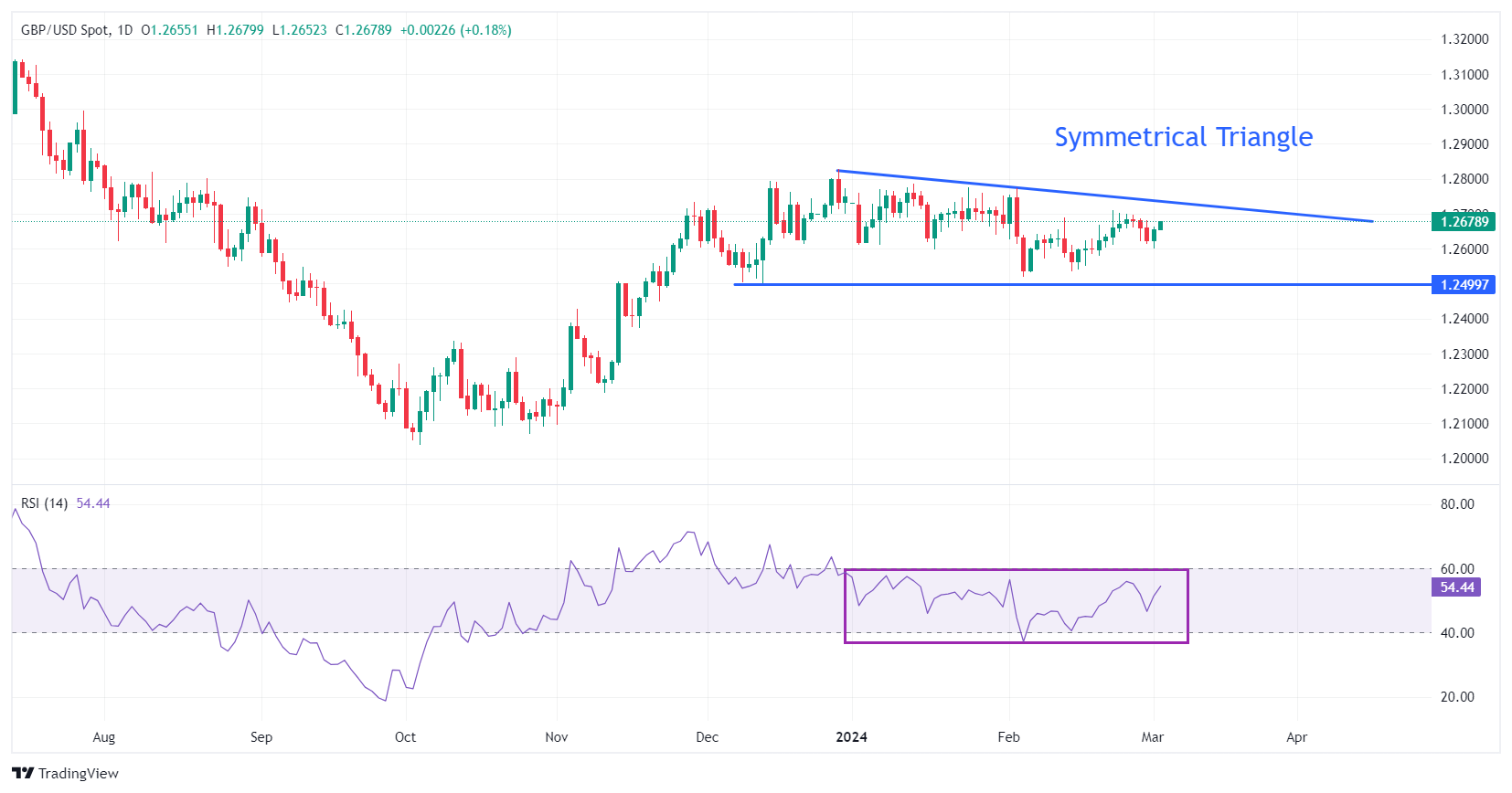
- Pound Sterling stretches its upside as markets expect the BoE to hold interest rates higher for longer than the Fed.
- UK inflation remains sticky, particularly in the services sector, due to solid wage growth.
- Investors await Fed Powell’s testimony for fresh cues on interest rate outlook.
The Pound Sterling (GBP) clings to gains, trading around 1.2670 on Monday’s European session as investors price in that the Bank of England (BoE) won’t lower interest rates anytime soon. The United Kingdom’s (UK) inflation rate remains the highest in the Group of Seven economies (G-7), forcing BoE policymakers to hold interest rates in the restrictive territory for a longer period.
Solid wage growth, which quickly feeds into inflation in the services sector, has kept the outlook of the UK’s core Consumer Price Index (CPI) sticky. BoE policymakers believe that the pace at which labor costs and service inflation are growing still doubles the pace required for inflation to sustainably return to the 2% target.
Prospects of higher interest rates benefit the Pound Sterling as this tends to attract higher foreign inflows.
This week, a light UK economic calendar could allow the market sentiment to guide the GBP/USD pair majorly. In the United States, Federal Reserve (Fed) Chair Jerome Powell’s testimony before Congress and the Nonfarm Payrolls (NFP) data will impact the market sentiment as they could provide fresh insights about when the Fed could start reducing interest rates.
Daily digest market movers: Pound Sterling jumps while US Dollar remains under pressure
- Pound Sterling holds onto gains against the US Dollar on Monday’s European session, extending the V-shape recovery from 1.2600 on Friday.
- The US Dollar faces a sell-off as the United States Institute of Supply Management (ISM) reported a weak set of Manufacturing PMI figures for February. The ISM reported a poor New Orders Index and signaled increased layoffs in the manufacturing sector, which indicates a weak economic outlook.
- This week, the US Dollar will be guided by the testimony of Fed Chair Jerome Powell before Congress and the labor market data for February. Powell may provide fresh guidance on the interest rate outlook.
- Meanwhile, the outlook of the United Kingdom economy improves as the S&P Global/CIPS reported an upbeat Manufacturing PMI for February. The Manufacturing PMI came in at 47.5, the highest since April 2023, beating expectations and the prior reading of 47.1. However, the index has remained below the 50.0 threshold in each of the past 19 months, which signals a contraction.
- In the Manufacturing PMI report, S&P Global reported that the New orders intake from the domestic and overseas economies has been hit hard due to client destocking, subdued market confidence, and financial pressures. The report also warned that factory owners faced challenging circumstances in February due to supply chain disruptions amid the Red Sea crisis. The supply issues have delayed raw material deliveries, eventually resulting in inflated input prices.
- Going forward, the Pound Sterling will be majorly guided by market expectations regarding the timing of rate cuts by the Bank of England. Investors see the BoE lowering its key interest rate from August. However, BoE policymakers may continue to lean towards maintaining interest rates at 5.25% until they get confident that inflation will return to the desired rate of 2%.
Technical Analysis: Pound Sterling advances toward 1.2700

The Pound Sterling extends its upside to 1.2670 after a strong recovery from the round-level support of 1.2600. The major approaches the downward-sloping border of the Descending Triangle pattern formed on a daily time frame, placed from December 28 high at 1.2827. The horizontal support of the aforementioned chart pattern is plotted from December 13 low near 1.2500.
A Descending Triangle pattern exhibits indecisiveness among market participants but with a slight downside bias due to lower highs and flat lows.
The 14-period Relative Strength Index (RSI) remains inside the 40.00-60.00 region, indicating a sharp volatility contraction.
BoE FAQs
The Bank of England (BoE) decides monetary policy for the United Kingdom. Its primary goal is to achieve ‘price stability’, or a steady inflation rate of 2%. Its tool for achieving this is via the adjustment of base lending rates. The BoE sets the rate at which it lends to commercial banks and banks lend to each other, determining the level of interest rates in the economy overall. This also impacts the value of the Pound Sterling (GBP).
When inflation is above the Bank of England’s target it responds by raising interest rates, making it more expensive for people and businesses to access credit. This is positive for the Pound Sterling because higher interest rates make the UK a more attractive place for global investors to park their money. When inflation falls below target, it is a sign economic growth is slowing, and the BoE will consider lowering interest rates to cheapen credit in the hope businesses will borrow to invest in growth-generating projects – a negative for the Pound Sterling.
In extreme situations, the Bank of England can enact a policy called Quantitative Easing (QE). QE is the process by which the BoE substantially increases the flow of credit in a stuck financial system. QE is a last resort policy when lowering interest rates will not achieve the necessary result. The process of QE involves the BoE printing money to buy assets – usually government or AAA-rated corporate bonds – from banks and other financial institutions. QE usually results in a weaker Pound Sterling.
Quantitative tightening (QT) is the reverse of QE, enacted when the economy is strengthening and inflation starts rising. Whilst in QE the Bank of England (BoE) purchases government and corporate bonds from financial institutions to encourage them to lend; in QT, the BoE stops buying more bonds, and stops reinvesting the principal maturing on the bonds it already holds. It is usually positive for the Pound Sterling.
Information on these pages contains forward-looking statements that involve risks and uncertainties. Markets and instruments profiled on this page are for informational purposes only and should not in any way come across as a recommendation to buy or sell in these assets. You should do your own thorough research before making any investment decisions. FXStreet does not in any way guarantee that this information is free from mistakes, errors, or material misstatements. It also does not guarantee that this information is of a timely nature. Investing in Open Markets involves a great deal of risk, including the loss of all or a portion of your investment, as well as emotional distress. All risks, losses and costs associated with investing, including total loss of principal, are your responsibility. The views and opinions expressed in this article are those of the authors and do not necessarily reflect the official policy or position of FXStreet nor its advertisers. The author will not be held responsible for information that is found at the end of links posted on this page.
If not otherwise explicitly mentioned in the body of the article, at the time of writing, the author has no position in any stock mentioned in this article and no business relationship with any company mentioned. The author has not received compensation for writing this article, other than from FXStreet.
FXStreet and the author do not provide personalized recommendations. The author makes no representations as to the accuracy, completeness, or suitability of this information. FXStreet and the author will not be liable for any errors, omissions or any losses, injuries or damages arising from this information and its display or use. Errors and omissions excepted.
The author and FXStreet are not registered investment advisors and nothing in this article is intended to be investment advice.